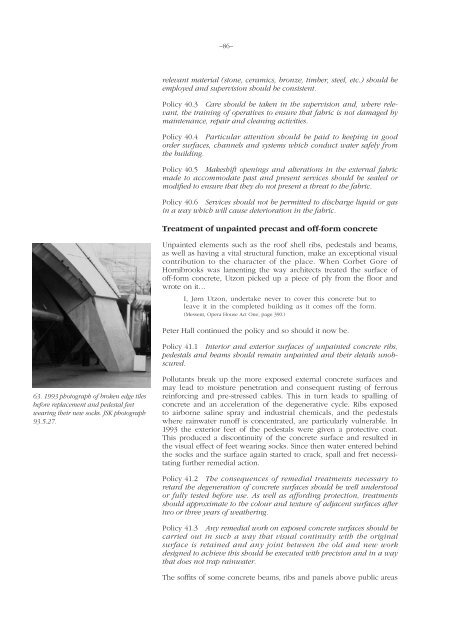Sydney Opera House conservation plan
Sydney Opera House conservation plan
Sydney Opera House conservation plan
You also want an ePaper? Increase the reach of your titles
YUMPU automatically turns print PDFs into web optimized ePapers that Google loves.
–86–relevant material (stone, ceramics, bronze, timber, steel, etc.) should beemployed and supervision should be consistent.Policy 40.3 Care should be taken in the supervision and, where relevant,the training of operatives to ensure that fabric is not damaged bymaintenance, repair and cleaning activities.Policy 40.4 Particular attention should be paid to keeping in goodorder surfaces, channels and systems which conduct water safely fromthe building.Policy 40.5 Makeshift openings and alterations in the external fabricmade to accommodate past and present services should be sealed ormodified to ensure that they do not present a threat to the fabric.Policy 40.6 Services should not be permitted to discharge liquid or gasin a way which will cause deterioration in the fabric.Treatment of unpainted precast and off-form concreteUnpainted elements such as the roof shell ribs, pedestals and beams,as well as having a vital structural function, make an exceptional visualcontribution to the character of the place. When Corbet Gore ofHornibrooks was lamenting the way architects treated the surface ofoff-form concrete, Utzon picked up a piece of ply from the floor andwrote on it…I, Jørn Utzon, undertake never to cover this concrete but toleave it in the completed building as it comes off the form.(Messent, <strong>Opera</strong> <strong>House</strong> Act One, page 390.)Peter Hall continued the policy and so should it now be.Policy 41.1 Interior and exterior surfaces of unpainted concrete ribs,pedestals and beams should remain unpainted and their details unobscured.63. 1993 photograph of broken edge tilesbefore replacement and pedestal feetwearing their new socks. JSK photograph93.5.27.Pollutants break up the more exposed external concrete surfaces andmay lead to moisture penetration and consequent rusting of ferrousreinforcing and pre-stressed cables. This in turn leads to spalling ofconcrete and an acceleration of the degenerative cycle. Ribs exposedto airborne saline spray and industrial chemicals, and the pedestalswhere rainwater runoff is concentrated, are particularly vulnerable. In1993 the exterior feet of the pedestals were given a protective coat.This produced a discontinuity of the concrete surface and resulted inthe visual effect of feet wearing socks. Since then water entered behindthe socks and the surface again started to crack, spall and fret necessitatingfurther remedial action.Policy 41.2 The consequences of remedial treatments necessary toretard the degeneration of concrete surfaces should be well understoodor fully tested before use. As well as affording protection, treatmentsshould approximate to the colour and texture of adjacent surfaces aftertwo or three years of weathering.Policy 41.3 Any remedial work on exposed concrete surfaces should becarried out in such a way that visual continuity with the originalsurface is retained and any joint between the old and new workdesigned to achieve this should be executed with precision and in a waythat does not trap rainwater.The soffits of some concrete beams, ribs and panels above public areas
















